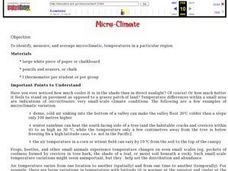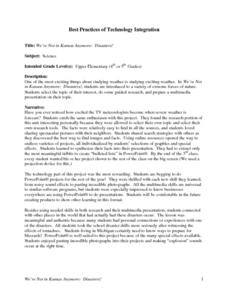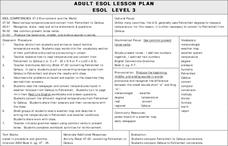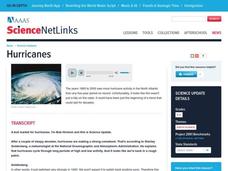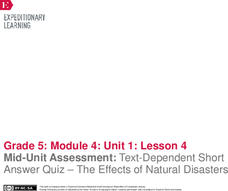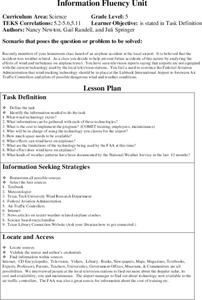Curated OER
How Can Storms Be Tracked?
In this storm worksheet, students will brainstorms what meteorologists track, why they track them, and how they track them. The students will write their ideas into a chart.
Curated OER
"Use an Anemometer," said the Meteorologist
Learners participate in an hands-on construction of an instrument to measure wind speed.
Curated OER
Weather Instrument Use and Application
Eighth graders measure temperature, wind speed and pressure using Skymaster SM-28. In this earth science lesson, 8th graders collect data and record observations taken from outdoors. They explain why numerical values are different in...
Scholastic
Study Jams! Clouds & Precipitation
Pretty pictures of water droplets, clouds, and snow-covered mountains are the backdrop for information about clouds and precipitation. With 10 slides in all, viewers see how and where clouds form as well as what forms of water can fall...
Curated OER
Computation with Fractions
Upper graders are introduced to the topic of fractions and percentages. In groups, they discuss real world situations in which fractions are present, and they complete a worksheet solving problems with common and uncommon denominators....
American Museum of Natural History
Tornadoes Spinning Thunderstorms
Tornado winds can reach more than 200 miles per hour. Learners explore wind speeds and more characteristics of tornadoes with an online lesson. They learn how tornadoes form and how scientists attempt to predict them. Can be used as an...
Curated OER
Micro-Climate
Atmosphere aces investigate the microclimates that exist within a larger area. They use a thermometer to record the varying temperatures and identify the microclimates on a map that they have drawn. This exercise helps them to understand...
Curated OER
Measuring Precipitation
A little engineering design is mixed into this lesson plan on precipitation measurement. Groups plan and construct a rain gauge, and use it to collect precipitation. As part of the PowerPoint presentation, learners view a satellite map...
Curated OER
Meterology -- Atmosphere
Fourth graders discover how weather predictions are made. They list the responsibilities of a meteorologist. They identify weather instruments and state their functions.
Curated OER
What's Going to Happen at Any Given Barometer Reading?
Fourth graders brainstorm a list of words associated with weather. In groups, they sort the words into categories and observe the weather in their area for a month. To end the lesson, they compare the barometer measurements for a...
Curated OER
Is it Partly Cloudy or Partly Sunny?
Students investigate the concept of weather and how it is created. They review relevant vocabulary related to weather. Students predict weather given slight background knowledge. The instructional activity includes background information...
Curated OER
We're Not in Kansas Anymore: Disasters!
Students explore weather. They discuss a variety of extreme forces of nature. Students select a topic of their interest and research that topic. They prepare a multimedia presentation on their selected weather topic. Students present...
Curated OER
Cloud Types and Formation of Clouds
Young scholars take cloud and weather related photographs during the year, making certain to make notes of when, where and what time the photograph was taken. At some point all the pictures be gathered and a scrapbook or "cloud library"...
Curated OER
Analyzing Meteorological Data From Mars
Students compare real-time Earth and Mars measurements for temperature, wind speed, humidity and atmospheric pressure by accessing Internet-data resources from NASA. They access real-time weather data and maps for their school location.
Curated OER
Temperature Conversions
Students discuss the different between the English system of measurement and the metric system. Working ins mall groups, students read the weather map. They convert temperatures from one measurement system to another.
Curated OER
Dripping Wet or Dry as a Bone?
Students use a sponge and water model to explore the concept of relative humidity and create a percent scale. They define humidity and saturation, build a simple humidity/saturation model, collect, predict and interpret data, and create...
Curated OER
Hurricanes
Pupils listen to a transcript of an interview about an upswing in hurricanes with Stanley Goldenberg, a researcher with the National Oceanographic and Atmospheric Administration. students participate in a series of discussion questions.
Curated OER
Hurricane and Tornadoes Vocabulary
Quiz your young meteorologists using this simple matching worksheet. Learners inventory 16 weather-related terms, matching them to the appropriate definition on the right. There are an equal number of definitions as there are terms. A...
Curated OER
Clouds Movement and Type
Students examine types of clouds and their movement. In this science lesson plan, students explore how to determine cloud movement and direction, differentiate between the different types of clouds, and predict the weather based on the...
Curated OER
Winter and Summer Storms Scenarios
Fourth graders discover the patterns that create summer and winter storms. Working in groups, they create model storms for summer and winter. Students discuss the reasons why summer storms and winter storms are different and explain...
EngageNY
Mid-Unit Assessment: Text-Dependent Short-Answer Quiz—The Effects of Natural Disasters
Readers complete a mid-unit assessment by reading the text How Do Hurricanes Form? They answer text-dependent questions about hurricanes with short answer and sequencing. Learners then participate in a read aloud and text chunking...
Curated OER
Everyone Knows It's Windy
Students create an anemometer, an instrument that measures wind speed.
Curated OER
Wind and The Airline
Fifth graders attempt to solve a problem related to an airline accident. The accident appears to be weather related. They analyze and research the effects of wind and turbulence in order to prevent future accidents.
Curated OER
Why Predict?
Twelfth graders examine the process of predicting. They observe a fine art transparency, discuss their predictions about the artwork, identify the types of predictions made during a weather broadcast, and evaluate headlines from...








